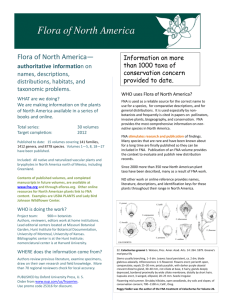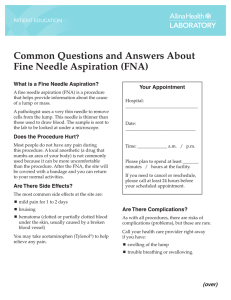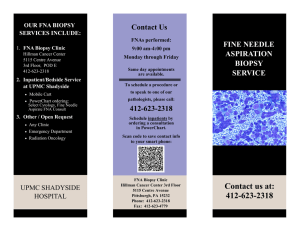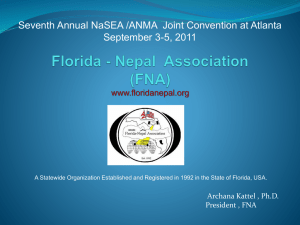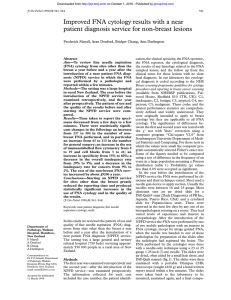Fine Needle Aspiration - Sullivan Nicolaides Pathology
advertisement
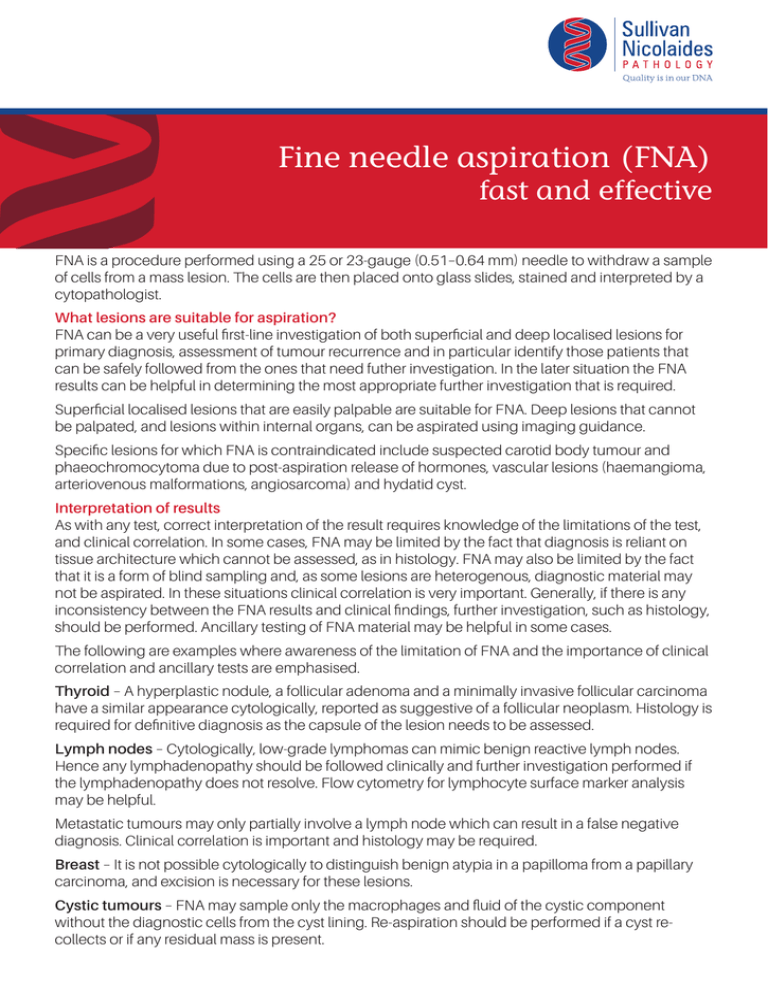
Fine needle aspiration (FNA) fast and effective FNA is a procedure performed using a 25 or 23-gauge (0.51–0.64 mm) needle to withdraw a sample of cells from a mass lesion. The cells are then placed onto glass slides, stained and interpreted by a cytopathologist. What lesions are suitable for aspiration? FNA can be a very useful first-line investigation of both superficial and deep localised lesions for primary diagnosis, assessment of tumour recurrence and in particular identify those patients that can be safely followed from the ones that need futher investigation. In the later situation the FNA results can be helpful in determining the most appropriate further investigation that is required. Superficial localised lesions that are easily palpable are suitable for FNA. Deep lesions that cannot be palpated, and lesions within internal organs, can be aspirated using imaging guidance. Specific lesions for which FNA is contraindicated include suspected carotid body tumour and phaeochromocytoma due to post-aspiration release of hormones, vascular lesions (haemangioma, arteriovenous malformations, angiosarcoma) and hydatid cyst. Interpretation of results As with any test, correct interpretation of the result requires knowledge of the limitations of the test, and clinical correlation. In some cases, FNA may be limited by the fact that diagnosis is reliant on tissue architecture which cannot be assessed, as in histology. FNA may also be limited by the fact that it is a form of blind sampling and, as some lesions are heterogenous, diagnostic material may not be aspirated. In these situations clinical correlation is very important. Generally, if there is any inconsistency between the FNA results and clinical findings, further investigation, such as histology, should be performed. Ancillary testing of FNA material may be helpful in some cases. The following are examples where awareness of the limitation of FNA and the importance of clinical correlation and ancillary tests are emphasised. Thyroid – A hyperplastic nodule, a follicular adenoma and a minimally invasive follicular carcinoma have a similar appearance cytologically, reported as suggestive of a follicular neoplasm. Histology is required for definitive diagnosis as the capsule of the lesion needs to be assessed. Lymph nodes – Cytologically, low-grade lymphomas can mimic benign reactive lymph nodes. Hence any lymphadenopathy should be followed clinically and further investigation performed if the lymphadenopathy does not resolve. Flow cytometry for lymphocyte surface marker analysis may be helpful. Metastatic tumours may only partially involve a lymph node which can result in a false negative diagnosis. Clinical correlation is important and histology may be required. Breast – It is not possible cytologically to distinguish benign atypia in a papilloma from a papillary carcinoma, and excision is necessary for these lesions. Cystic tumours – FNA may sample only the macrophages and fluid of the cystic component without the diagnostic cells from the cyst lining. Re-aspiration should be performed if a cyst recollects or if any residual mass is present. Non-diagnostic (unsatisfactory) specimens A specimen is non-diagnostic if there is insufficient cellular material on the slides for assessment. This may be due to the nature of the lesion, for example, an extensively necrotic tumour may yield debris only. Sometimes aspirating the edge of such tumours may help. Some tumours may be sclerotic and cellular material may not be obtainable. Non-diagnostic specimens may be the result of the cellular material being obscured by blood or inflammatory cells. Problems in smear preparation, such as crush artefact or air-drying prior to fixation can also render specimens unsatisfactory. Close communication with the reporting pathologist may help to reduce such problems. These two photographs highlight the necessity for good smear preparation Well preserved cells in which assessment of nuclear detail enables a diagnosis of malignancy. (Pap smear x 40) Poorly preserved cells as a result of air drying due to a delay in fixation. Nuclear detail is unable to be assessed and a diagnosis cannot be made. (Pap smear x 40) To obtain an FNA kit Clinicians may obtain a fine needle aspiration kit, which contains the necessary equipment for performing an aspirate, by contacting: Doctor Services or your Medical Liaison Manager 1300 SNPATH (1300 767 284) Nonpalpable lesions and lesions within internal organs should be aspirated under image guidance and require referral to a radiologist skilled in the procedure. Dr Ann Whitehouse FRCPA Ann graduated from The University of Queensland and trained in histopathology in Victoria, NSW, SA, and WA. Following several years with Douglass Hanly Moir Pathology, Sydney, Ann returned to Queensland to work in the private sector, joining Sullivan Nicolaides Pathology in 2001. Ann’s interests include breast pathology, gynaepathology, and cytopathology. Dr Whitehouse is available for consultation. T: (07) 3377 8672 E: ann_whitehouse@snp.com.au SULLIVAN NICOLAIDES PTY LTD • ABN 38 078 202 196 • A subsidiary of Sonic Healthcare Limited • ABN 24 004 196 909 134 WHITMORE STREET • TARINGA • QLD 4068 • AUSTRALIA TEL (07) 3377 8666 • FAX (07) 3870 0549 P O BOX 344 • INDOOROOPILLY • QLD 4068 • AUSTRALIA www.snp.com.au Meridio 176582 June 2016 Correct at time of printing. www.snp.com.au © Sullivan Nicolaides Pty Ltd 2016
